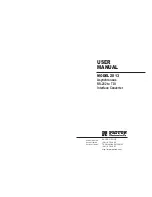
Owner’s Reference
DirectStream DAC
4826 Sterling Drive, Boulder, CO 80301
PH: 720.406.8946 [email protected] www.psaudio.com
Introduction v
®
©2014 PS Audio Inc. All rights reserved.
Introduction
The heart of DirectStream is the DSD engine itself. Regardless of input format, whether
PCM or DSD, all data are upsampled to 30 bits running at 10 times the standard DSD
rate and then back down again to double rate DSD for noise shaping.
The internal volume control keeps complete precision: every bit in the input affects
the output of the DAC for any volume level. Except for the sigma-delta modulation
process itself there is no rounding, dither or other trimming, not to 24 bits, not to 32
bits, not to 48 bits, but rather a full 50. The incoming PCM signal is 30 bits from the
upsampling filter and the volume control is 20 bits wide so all 50 bits of the output are
used throughout the sigma-delta conversion, requiring more than 50 bits of precision.
DSD only requires a nominal 20 bit signal to noise ratio, this design utilizes a minimum
width of 24 bits with wide filter coefficients and 144dB S/N. Use of full precision
everywhere and many guard bits in the IIR filters and the sigma-delta modulator help
maintain our goal of perfecting the audio output.
While some designs may run out of headroom or approach saturation levels,
depending on the source material, the new design opts for an extra top bit everywhere
in the digital path coupled with an extra 6 dB of head room in the analog path beyond
the 6 dB of headroom that SACD uses. The top bit keeps PCM from saturating, even if
that PCM was not properly bandwidth limited in the initial recording process.
The output of the DSD engine is fed directly into the output stage, based on high
speed video amplifiers and a passive output transformer.
Most output schemes for DSD modulators are active low pass filters, covering
the required 120dB S/N ratio from 10Hz to 220MHz and have a number of design
challenges and problems associated with even the best designs.
If the analog processing isn’t linear and doesn’t have a very wide bandwidth it will
modulate the high frequency noise that’s inherent in DSD back into the audio band.
That modulation will not result in just low level noise. In practice it will be aliased
back into the audible band with serious sonic consequences. To maintain low noise
and linearity, the design incorporates both high speed symmetrical video amps and
a passive output filter. The first challenge in such a design is the output switch that
generates the final 1’s and 0’s of the modulator.
A very clean switch that hooks up the positive rail with a 1 and the negative rail with a
0 is essential. If it has too much resistance, if the resistance is different at the positive
end than the negative end, if the resistance changes from time to time, … the result will
not be as clean as it needs to be. For 120dB S/N the switch resistance has to be quite
consistent. Another design requirement is consistent and fast switching time.
Full headroom
with room to
spare
Transformer
coupled
outputs
Clean
switching
The DSD
engine is it's
heart






































